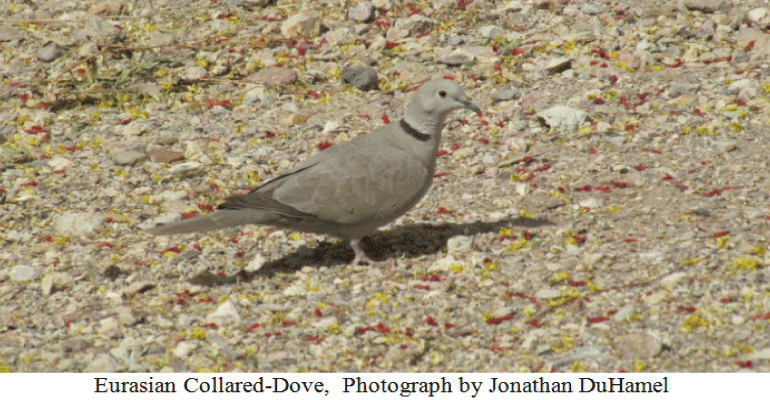
Have you seen this bird? Collared doves have been showing up in my backyard for the past few years. They flock with other doves and I rarely seen more than one collared dove at a time.
The Eurasian Collared-Dove (Streptopelia decaocto) is about 12 inches long and has a wingspan of about 14 inches which makes it larger than a Mourning dove and about the same size as a White-winged dove.
According to the Cornell Lab of Ornithology:
“Eurasian Collared-Doves made their way to North America via the Bahamas, where several birds escaped from a pet shop during a mid-1970s burglary; the shop owner then released the rest of the flock of approximately 50 doves. Others were set free on the island of Guadeloupe when a volcano threatened eruption. From these two sites the birds likely spread to Florida, and now occur over most of North America.”
Eurasian Collared-Doves eat mainly seeds and cereal grains. They will occasionally eat berries, plant greens, and bugs. Their principal habitat appears to be urban and suburban areas, especially where people put out bird feeders. They may also occur on farms.
“Mainly ground foragers, they peck at grain and seeds scattered beneath backyard feeders and on feeding platforms, or spilled at farmyards. Flocks of 10 to several hundred doves may gather at prime spots. Although they can feed peacefully in mixed flocks, Eurasian Collared-Doves will also chase off other birds, including Mourning Doves, cardinals, and Blue Jays.” (Cornell)
Nesting (source, Cornell):
“The male dove brings the female twigs, grasses, roots and other nesting materials, which he sometimes pushes directly under her. Over 1 to 3 days she builds a simple platform nest, which may include feathers, wool, string and wire. A pair often uses the same nest for multiple broods during the year, and may renovate old nests.
“Males show females potential nest sites in trees and on buildings, giving a low- pitched, slow koo-KOO-kook call at each site (listen here). Nests are usually built 10 or more feet above the ground. In warmer regions, Eurasian Collared-Doves can nest year-round, which may help explain their success as colonizers.”
“Eurasian Collared-Doves are one of very few species that can drink “head down,” submerging their bills and sucking water as though drinking through a straw. Most birds must scoop water and tip the head back to let it run down into the throat.” (Cornell)
Eurasian Collared-Doves may be mistaken for Ringed Turtle Doves which are slightly smaller and lighter in color. According to the Sibley Guide to Birds, the Ringed Turtle Dove is a domestic variety, not a naturally occurring species, and it fares poorly in the wild.
See also:
Note to readers:
Index with links to all my ADI articles: http://wp.me/P3SUNp-1pi
My comprehensive 28-page essay on climate change: http://wp.me/P3SUNp-1bq
